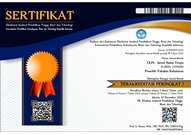The potential of stingless bees cultivation with agroforestry techniques in “Kebun Sidang” Antutan Village, Bulungan District, Indonesia
Abstract
Keywords
Full Text:
PDFReferences
Cortopassi-Laurino, M., Imperatriz-Forseca, V.L., Roubik, D.W., Dollin, A., Heard, T., Aguilar, I., Venturieri, G.C., Eardley, C., & Noguiera-Neto, P. (2006). Global meliponiculture: challenges and opportunities. Apidologie, 37, 275-292.
Dewantari, M., Suranjaya, I.G. (2019). Pengembangan Budidaya Lebah Madu Trigona spp Ramah Lingkungan di Desa Antapan Kecamatan Baturiti Kabupaten Tabanan. Buletin Udayana Mengabdi, 18(1),114-119.
https://doi.org/10.24843/BUM.2019.v18.i01 . p23
Harmonis, Sutisna, M., Mardji, D., & Iskandar, R. E. (2007). Potensi dan Prospek Pengembangan Usaha Perlebahan di Kalimantan Timur. Rimba Kalimantan, 12(1). 25–34
Idris, A. I., Arafat, A., & Fatmawati, D. (2019). Pola dan Motivasi Agroforestri serta Kontribusinya Terhadap Pendapatan Petani Hutan Rakyat di Kabupaten Polewali Mandar. Jurnal Hutan dan Masyarakat, II(2), 92-113.
Istikowati, W. T., Sunardi, S., Soendjoto, M. A., & Syaifuddin, S. (2019). Pengembangan Budidaya Lebah Kelulut di Desa Batu Tanam, Sambung Makmur, Kabupaten Banjar, Kalimantan Selatan. PengabdianMu: Jurnal Ilmiah Pengabdian Kepada Masyarakat, 5(1), 59–66.
https://doi.org/10.33084/pengabdianmu.v5i1.983
Joice, R. J. I., & Maramis, R. T. D. (2015). Penggunaan Metode Queen Rearing Terhadap Pembentukan Sel Ratu Apis mellifera Untuk Pengembangan Perlebahan. Jurnal Zootek, 35(2), 235-246.
Ma’ruf, M., Mawaddah, G.A., Eriana, N.N.A., Swari, F.I., Aslamiah, S., Lutpiatina, L. (2018). Madu Lebah Kelulut (Trigona spp.) dalam Aktifitas terhadap Bakteri Staphylococcus aureus Resisten. Jurnal Skala Kesehatan: Politeknik Kesehatan Banjarmasin, 9(1), 21-26. https://doi.org/10.31964/jsk.v9i1.151
Noordwijk, M. V., Agus, F. Suprayogo, D., Hairiah, K., Pasya, G., Verbistl, B., & Farida. (2011). Peranan Agroforestri dalam Mempertahankan Fungsi Hidrologi Daerah Aliran Sungai (DAS). Jurnal Agrivita. 26 (1), 1-8.
Olivi, R., Qurniati, R., & Firdasari. (2015). Kontribusi Agroforestri terhadap Pendapatan Petani di Desa Sukoharjo 1 Kecamatan Sukoharjo Kabupaten Pringsewu. Jurnal Sylva Lestari. 3(2), 1-12.
Panjaitan, I. (2017). Analisis Usaha dan Pemasaran Lebah Madu (Apis melifera) (Studi Kasus: Desa Silo Baru, Kecamatan Silau Laut, Kabupaten Asahan, Povinsi Sumatera Utara) [Skripsi]. Fakultas Pertanian. Universitas Muhammadiyah Sumatera Utara.
Rochman, N., Junus, M., & Ciptadi, G. (2014). Estimasi Bobot Larva Melalui Panjang dan Berat Larva Lebah Hutan [Skripsi]. Fakultas Peternakan. Universitas Brawijaya. Malang.
Satriadi, T., Aryadi, M., & Fauzi, H. (2015). Potensi Pakan Lebah pada Hutan Kemasyarakatan Model Berbasis Agroforestri di Kabupaten Tanah Laut
Kalimantan Selatan. Dalam Prosiding Seminar Nasional Agroforestri 2015. Halaman 137-143. Balai Penelitian dan Pengembangan Teknologi Agroforestri. ISBN: 978-602-17616-6-3.
Soekartawi. (2003). Prinsip Ekonomi Pertanian. Rajawali Press. Jakarta.
Soekartawi. (2006). Analisis Usahatani. Penerbit Universitas Indonesia. Jakarta.
Stoner, K.A., (2012). Planting Flowers for Bees in Connecticut. Department of Entomology The Connecticut Agricultural Experiment Station, New Haven. USA.
Surata, I.K. (2017). Budidaya Lebah Madu Kele-Kele (Trigona spp.). Buku saku /Buku Pedoman. Dalam: Dewantari, M., dan Suranjaya, I. G. (Editor). Pengembangan Budidaya Lebah Madu Trigona spp Ramah Lingkungan di Desa Antapan Kecamatan Baturiti Kabupaten Tabanan. (2019). Vol 18(1).
Syaifudin, S. M. (2020). Budidaya Pakan Lebah Trigona sp. dengan Apiculture Agroforestry System di Kelurahan Anjungan Melancar, Kecamatan Anjungan Kabupaten Mempawah. Jurnal Ilmiah Pangabdhi, 6(1), 17–24. https://doi.org/10.21107/pangabdhi.v6i1.6 932.
Widiarti, A., & Kuntadi. (2012). Budidaya Lebah Madu Apis mellifera Oleh Masyarakat
Pedesaan Kabupaten Pati, Jawa Tengah. Jurnal Penelitian Hutan dan Konservasi Alam, 9 (4), 351-361.
Wulandari, C. (2011). Agroforestry: Kesejahteraan Masyarakat dan Konservasi Sumber Daya Alam. Buku. Univeritas Lampung. Bandar Lampung. 78 hlm.
Ya’akob, H. , N. F. Norhisham, M. Mohamed, N. Sadek, S. & Endrini. (2019). Evaluation of Psycochemical Properties of Trigona sp. Stingless Bee Honey from Various Districs of Johor (Kajian Fizikokimia Terhadap Trigon sp. Madu Lebah Kelulut di Daerah Johor). Jurnal Kejurutaraan S1, 2(1), 59-67. https://doi.org/10.17576/jkukm-2019-si2(1)-8
Yustha, Y. (2017). Pemanfaatan Lahan Pekarangan dengan Sistem Agroforestri oleh Masyarakat di Desa Sidomulyo, Katingan Kuala, Katingan. Jurnal Agrisilvika, 2(4), 56-63.
DOI: http://dx.doi.org/10.32522/ujht.v9i1.15881
Refbacks
- There are currently no refbacks.
Copyright (c) 2025 Marjenah Marjenah, Harmonis Harmonis, Ona Orvalinda

This work is licensed under a Creative Commons Attribution-ShareAlike 4.0 International License.
Ulin : Jurnal Hutan Tropis |
Forestry Faculty of Mulawarman University Jl. Penajam Kampus Gunung Kelua Samarinda 75123 E-Mail: ulin.jhuttrop@fahutan.unmul.ac.id |
Support Contact Lisa Andani |
|



